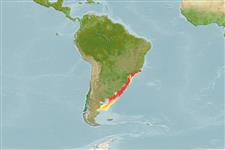>
Gadiformes (Cods) >
Phycidae (Phycid hakes)
Etymology: Urophycis: Greek, oura = tail + Greek, phyke, pykis, -idos = the female of a fish that lives among algae (Greek = phykon), related with the gudgeon (Ref. 45335).
More on author: Kaup.
Environment: milieu / climate zone / depth range / distribution range
Écologie
marin démersal; non migrateur; profondeur 24 - 190 m. Subtropical; 21°S - 46°S, 68°W - 41°W
Southwest Atlantic: southern Brazil, Uruguay, Argentina and Falkland Is.
Taille / Poids / Âge
Maturity: Lm ? range ? - ? cm
Max length : 58.6 cm TL mâle / non sexé; (Ref. 39376); common length : 25.0 cm TL mâle / non sexé; (Ref. 6077)
Épines dorsales (Total): 0; Rayons mous dorsaux (Total): 62-69; Épines anales 0; Rayons mous anaux: 43 - 46. Body elongated; head small; eyes small. First dorsal-fin ray elongated; pelvic fins extending beyond the origin of the anal fin. Mottled pattern on back and upper sides.
Life cycle and mating behavior
Maturité | Reproduction | Frai | Œufs | Fécondité | Larves
Cohen, D.M., T. Inada, T. Iwamoto and N. Scialabba, 1990. FAO species catalogue. Vol. 10. Gadiform fishes of the world (Order Gadiformes). An annotated and illustrated catalogue of cods, hakes, grenadiers and other gadiform fishes known to date. FAO Fish. Synop. 125(10). Rome: FAO. 442 p. (Ref. 1371)
Statut dans la liste rouge de l'IUCN (Ref. 130435)
Menace pour l'homme
Harmless
Utilisations par l'homme
Pêcheries: commercial
Plus d'informations
RéférencesAquacultureProfil d'aquacultureSouchesGénétiqueElectrophoresesHéritabilitéPathologiesTraitementNutrientsMass conversion
Outils
Articles particuliers
Télécharger en XML
Sources Internet
Estimates based on models
Preferred temperature (Ref.
123201): 20.6 - 25.5, mean 24.8 °C (based on 9 cells).
Phylogenetic diversity index (Ref.
82804): PD
50 = 0.5044 [Uniqueness, from 0.5 = low to 2.0 = high].
Bayesian length-weight: a=0.00427 (0.00359 - 0.00507), b=3.16 (3.11 - 3.21), in cm total length, based on LWR estimates for this species (Ref.
93245).
Niveau trophique (Ref.
69278): 3.9 ±0.68 se; based on food items.
Résilience (Ref.
120179): Milieu, temps minimum de doublement de population : 1,4 à 4,4 années (Assuming tm=2-3).
Prior r = 0.51, 95% CL = 0.33 - 0.76, Based on 2 stock assessments.
Fishing Vulnerability (Ref.
59153): Moderate vulnerability (43 of 100).
Climate Vulnerability (Ref.
125649): Low to moderate vulnerability (28 of 100).
Nutrients (Ref.
124155): Calcium = 65.1 [28.8, 136.9] mg/100g; Iron = 1 [1, 2] mg/100g; Protein = 18.5 [17.2, 19.8] %; Omega3 = 0.351 [0.185, 0.642] g/100g; Selenium = 30.9 [16.8, 61.3] μg/100g; VitaminA = 12.5 [3.9, 37.5] μg/100g; Zinc = 0.66 [0.47, 0.94] mg/100g (wet weight);
